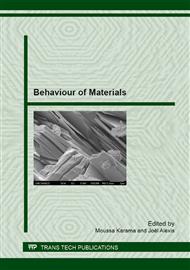p.107
p.115
p.127
p.135
p.143
p.157
p.165
p.171
p.179
Models of Adhesive Bonding of Hybrid Structures
Abstract:
Adhesives are often based on polymers materials. They are good candidates in order to manufacture adhesives joint because of their thermomechanical properties and their processing which is easier than other materials. Epoxy resins are widely used as adhesives joint. We can meet them in various industrial areas like car, spatial and aerospace domains. Because of numerous combinations between epoxy and amine chemical functions, these joints may be efficient at high or at low temperature. Indeed, close to their glassy transition temperature (Tg), exists an elastic modulus / ductility couple for which, shear stress is optimum: the Optimum Stress Zone (OSZ)[ which is restricted on limited temperatures range. Our study consists in formulating an epoxy amine joint able to be efficient on an extended temperatures range i.e. a joint able to ensure a stress continuity over a large range of temperatures, for example-50°C to 100°C. To reach this objective, we propose an evolution of the Multi Adhesive Joints (MAJ): an adhesive joint presenting a gradient of mechanical properties. To make this adhesive joint formulation possible, its necessary to control kinetics diffusion at the adhesive scale (200μm to 500μm) between the low temperature adhesive (LTA) and the high temperature adhesive (HTA). The diffusion study will be carried out by using a rheometer. For such adhesive thickness, the rheometer compliance may have an influence on the results. Therefore, this present work proposes to identify and to set up the key parameters, which allow following kinetics diffusion in a rheometer for dimensions similar to those of bonding assembly, by checking the measurements are performed in the linear viscoelastic domain. In a first part, the morphological, mechanical and thermomechanical properties of the nanostructured thermosets versus time are performed. And, the second part will deal with the optimization of the key parameters by performing dynamic shear tests versus time on HTA and LTA samples in sight of kinetics diffusion study.
Info:
Periodical:
Pages:
143-155
Citation:
Online since:
April 2013
Authors:
Price:
Сopyright:
© 2013 Trans Tech Publications Ltd. All Rights Reserved
Share:
Citation:


